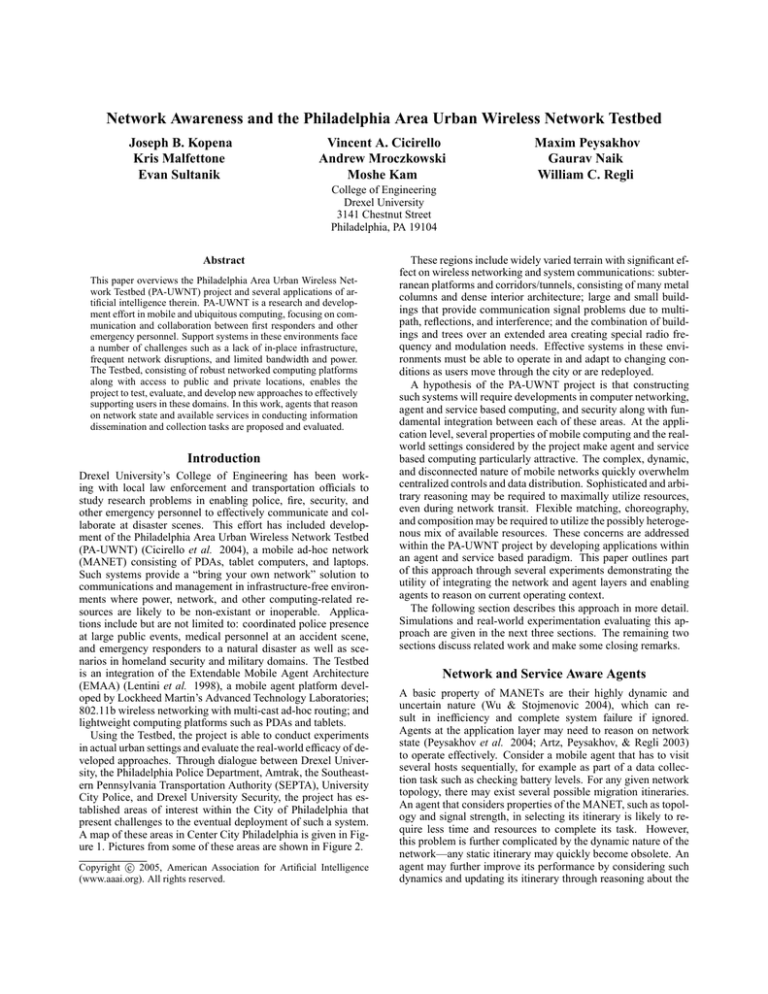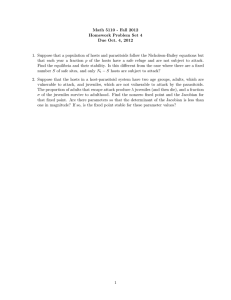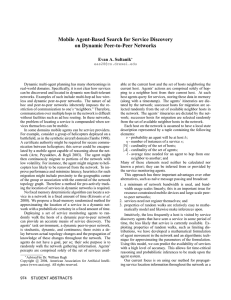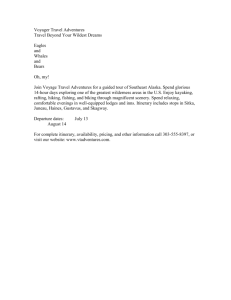
Network Awareness and the Philadelphia Area Urban Wireless Network Testbed
Joseph B. Kopena
Kris Malfettone
Evan Sultanik
Vincent A. Cicirello
Andrew Mroczkowski
Moshe Kam
Maxim Peysakhov
Gaurav Naik
William C. Regli
College of Engineering
Drexel University
3141 Chestnut Street
Philadelphia, PA 19104
Abstract
This paper overviews the Philadelphia Area Urban Wireless Network Testbed (PA-UWNT) project and several applications of artificial intelligence therein. PA-UWNT is a research and development effort in mobile and ubiquitous computing, focusing on communication and collaboration between first responders and other
emergency personnel. Support systems in these environments face
a number of challenges such as a lack of in-place infrastructure,
frequent network disruptions, and limited bandwidth and power.
The Testbed, consisting of robust networked computing platforms
along with access to public and private locations, enables the
project to test, evaluate, and develop new approaches to effectively
supporting users in these domains. In this work, agents that reason
on network state and available services in conducting information
dissemination and collection tasks are proposed and evaluated.
Introduction
Drexel University’s College of Engineering has been working with local law enforcement and transportation officials to
study research problems in enabling police, fire, security, and
other emergency personnel to effectively communicate and collaborate at disaster scenes. This effort has included development of the Philadelphia Area Urban Wireless Network Testbed
(PA-UWNT) (Cicirello et al. 2004), a mobile ad-hoc network
(MANET) consisting of PDAs, tablet computers, and laptops.
Such systems provide a “bring your own network” solution to
communications and management in infrastructure-free environments where power, network, and other computing-related resources are likely to be non-existant or inoperable. Applications include but are not limited to: coordinated police presence
at large public events, medical personnel at an accident scene,
and emergency responders to a natural disaster as well as scenarios in homeland security and military domains. The Testbed
is an integration of the Extendable Mobile Agent Architecture
(EMAA) (Lentini et al. 1998), a mobile agent platform developed by Lockheed Martin’s Advanced Technology Laboratories;
802.11b wireless networking with multi-cast ad-hoc routing; and
lightweight computing platforms such as PDAs and tablets.
Using the Testbed, the project is able to conduct experiments
in actual urban settings and evaluate the real-world efficacy of developed approaches. Through dialogue between Drexel University, the Philadelphia Police Department, Amtrak, the Southeastern Pennsylvania Transportation Authority (SEPTA), University
City Police, and Drexel University Security, the project has established areas of interest within the City of Philadelphia that
present challenges to the eventual deployment of such a system.
A map of these areas in Center City Philadelphia is given in Figure 1. Pictures from some of these areas are shown in Figure 2.
c 2005, American Association for Artificial Intelligence
Copyright (www.aaai.org). All rights reserved.
These regions include widely varied terrain with significant effect on wireless networking and system communications: subterranean platforms and corridors/tunnels, consisting of many metal
columns and dense interior architecture; large and small buildings that provide communication signal problems due to multipath, reflections, and interference; and the combination of buildings and trees over an extended area creating special radio frequency and modulation needs. Effective systems in these environments must be able to operate in and adapt to changing conditions as users move through the city or are redeployed.
A hypothesis of the PA-UWNT project is that constructing
such systems will require developments in computer networking,
agent and service based computing, and security along with fundamental integration between each of these areas. At the application level, several properties of mobile computing and the realworld settings considered by the project make agent and service
based computing particularly attractive. The complex, dynamic,
and disconnected nature of mobile networks quickly overwhelm
centralized controls and data distribution. Sophisticated and arbitrary reasoning may be required to maximally utilize resources,
even during network transit. Flexible matching, choreography,
and composition may be required to utilize the possibly heterogenous mix of available resources. These concerns are addressed
within the PA-UWNT project by developing applications within
an agent and service based paradigm. This paper outlines part
of this approach through several experiments demonstrating the
utility of integrating the network and agent layers and enabling
agents to reason on current operating context.
The following section describes this approach in more detail.
Simulations and real-world experimentation evaluating this approach are given in the next three sections. The remaining two
sections discuss related work and make some closing remarks.
Network and Service Aware Agents
A basic property of MANETs are their highly dynamic and
uncertain nature (Wu & Stojmenovic 2004), which can result in inefficiency and complete system failure if ignored.
Agents at the application layer may need to reason on network
state (Peysakhov et al. 2004; Artz, Peysakhov, & Regli 2003)
to operate effectively. Consider a mobile agent that has to visit
several hosts sequentially, for example as part of a data collection task such as checking battery levels. For any given network
topology, there may exist several possible migration itineraries.
An agent that considers properties of the MANET, such as topology and signal strength, in selecting its itinerary is likely to require less time and resources to complete its task. However,
this problem is further complicated by the dynamic nature of the
network—any static itinerary may quickly become obsolete. An
agent may further improve its performance by considering such
dynamics and updating its itinerary through reasoning about the
Figure 1: PA-UWNT Testing Areas within the City of Philadelphia.
uncertainty of the MANET, for example predicting future topological change. By reasoning on current and predicted network
state, an agent is more likely to return timely results, potentially
preventing costly system failures.
Figure 3 illustrates this ability. An agent has to collect data
from hosts {A, B, C, D} in Figure 3(a), starting from host X.
Visiting the hosts in that order creates redundant network hops,
as shown in Figure 3(b). To migrate from host A to B, the agent
has to be relayed through host C. It immediately returns there in
following the itinerary, then is relayed through B again in continuing on to D. This extraneous network traffic wastes time,
bandwidth, power, and other resources on each of those hosts.
To avoid these extra hops, the agent must sense and plan on the
network topology, developing the itinerary {A, C, B, D}. In addition, to avoid similar situations as conditions change it must
continually poll the network and replan, as in Figure 3(c).
In addition to perceiving and reacting to network state, agents
must also reason on available services and resources. Agents
traveling to specific targets are subject to required services becoming unavailable through events such as host outages, transmission delays, and link disruptions. Disseminating knowledge
of available services allows agents to search for alternatives and
respond to such failures. Figure 4 illustrates an example in which
agents recover from a network failure by switching to an alternative service provider. By regularly consulting knowledge of
available services, agents may direct migration through the network and continually move toward the closest provider. In this
way, service-based agents are afforded more flexibility and an
increased ability to react to changing conditions.
Network-Aware Data Synchronization Agents
In this experiment, there is a set of mobile network hosts, each
of which require some piece of data about the distributed system
state. The state of the hosts is changing over time as they move
about in their physical environment. The hosts require a view of
the others that is as up-to-date as possible. For example, if the
hosts are a team of mobile robots mapping an area, then the task
is to synchronize mapping information. If the hosts are tablet
PCs on which a shared whiteboard application is functioning,
then the task is to synchronize the state of the whiteboard.
Mobile agents are used to synchronize the data across the set
of hosts. An agent carries with it the latest copy of the data that
it has received about the state of each individual host. When
the agent migrates to a host, it merges its data with the host’s
latest data, updating both the host and the agent. The agent then
migrates to another host and continues this process. Timestamps
are used in this data merge process to ensure that the agent keeps
the most up-to-date information.
The experiment is run in MATES (Sultanik, Peysakhov, &
Regli 2004), an open-source, lightweight, discrete-event simulator specifically designed for testing mobile agent control logic
in MANET environments. The simulation uses a mobility model
that moves a host randomly at each iteration. Hosts can wander
out of radio range, but network partitions are prevented. There
is always a route between two hosts, although it may consist
of several hops. Routing data is made available to the agents.
This means that an agent is aware of the neighbors of its current host as well as information on how to reach non-neighbor
hosts. The term destination means the next host on the agent’s
itinerary. If hosts are within radio range, a link exists between
them. Agents take exactly one simulation iteration to travel
across a link. Agents have no knowledge of each other and do
not communicate. Each simulation lasts for 100,000 iterations.
The number of agents working collaboratively is varied from one
to four. Four types of agents are considered as described below.
Each type differs by the agent mobility pattern used.
◦ FixedAgent. Tries to visit every host on the network in a
pre-specified order. Once the FixedAgent reaches the last
host on its itinerary, it tries to migrate back to the first host
and repeats the process iteratively. Note that the FixedAgent
may migrate through hosts to reach its next destination if it
cannot be reached in a single hop.
◦ ReorderableAgent. Tries to visit every host on its itinerary,
migrating to the closest (fewest network hops) unvisited host
on its itinerary instead of simply choosing the next host.
If more than one host is considered closest, it randomly
chooses one of them. Once the ReorderableAgent has visited all of the hosts on its itinerary, its itinerary is reset and
Figure 2: Examples of urban testing areas in Philadelphia.
it begins touring the network again. The ReorderableAgent
does not update intermediary hosts on its way to its next destination. These intermediary hosts are used only to route the
agent to the next host on its itinerary.
◦ RandomAgent. Chooses its destination randomly from its
neighbors. This agent does not maintain any record of hosts
it has visited, nor does it have a set itinerary. The RandomAgent synchronizes on every migration since it always
chooses its next destination from its neighbors.
◦ GradientAgent. Does not have an itinerary, but keeps track
of visits to each host by incrementing a counter after a successful migration. The next destination of this agent is the
neighbor with the least number of prior visits. If more than
one host has an equal number of visits, the GradientAgent
chooses randomly from among them. Like the RandomAgent, this agent updates every host to which it migrates.
System performance is measured in terms of the team of homogenous agents present in the system (may be a single agent).
The objective that we call out-of-dateness is defined as:
OutOfDateness =
∑
h∈H
Type
Random
Random
Random
Random
Fixed
Fixed
Fixed
Fixed
Reorderable
Reorderable
Reorderable
Reorderable
Gradient
Gradient
Gradient
Gradient
# of Agents
1
2
3
4
1
2
3
4
1
2
3
4
1
2
3
4
Mean
12915.547
5804.275
3911.574
2791.396
3877.396
4300.934
4667.739
4584.596
1593.642
1127.592
909.967
780.212
2346.064
1474.223
1127.283
893.248
Std. Dev.
8605.03
3584.82
2745.25
1859.25
775.72
947.05
1021.92
996.77
335.38
271.91
229.27
202.48
722.29
512.70
434.06
349.83
Table 1: Performance of several different migration logics for
data synchronization agents on a 20-host MANET.
max(T − Th (g)),
g∈H
Where H is the set of hosts in the MANET, T is the current time,
and Th (g) is the time that host h was most recently updated about
the state information of host g. Table 1 reports OutOfDateness
results for different quantities of agents for each of the agent
types on networks consisting of 20 hosts. Results are averaged
across 100,000 simulation time units.
Some observations can be made from these results. Notably,
the two best migration logics for this problem of those evaluated
are the Re-orderable Itinerary and the Gradient-based patterns.
Both of these require some degree of network awareness. Further, the ReorderableAgent performs slightly better. This can be
attributed to this agent type’s usage of an itinerary to ensure it
visits each of the hosts. The GradientAgent always chooses a
neighbor as its next destination. The next best agent type in this
example is the RandomAgent. This leads one to speculate the
possible reasons that the FixedAgent performs worse than random. Recall that the FixedAgent uses a Pre-defined Itinerary,
using multi-hop routes if necessary to visit and update the set of
hosts in a pre-specified order. If the network topology is static,
then one can handcraft an efficient pre-defined itinerary. Or if the
network is fully-connected then any pre-defined itinerary would
be as good as any other since every host would be a single hop
away from any other. But given the dynamic nature of a MANET,
a fixed itinerary can lead to migration involving long routes between consecutive stops on the itinerary.
Services and Late-Binding on MANETs
Figure 5 illustrates a typical MANET scenario consisting of a set
of wireless, mobile hosts. Agents on host A need to use some
service, available on each host Si . In Figure 5(a), host A is connected to S0 and less directly to S1 . However, these nodes are
in motion and the closest provider rapidly changes, as in Figures 5(b) and 5(c). S0 eventually disconnects completely from A
in Figure 5(d). Agents in such a dynamic world must be able to
(a) An agent from X is to collect
data from hosts A, B, C, and D.
(b) The itinerary A, B, C, D produces redundant network hops. In migrating from A to B, the network
will relay the agent through C under this topology, only to have it return there later in the itinerary.
(c) By sensing network topology and developing a more efficient tour, the agent can avoid the redundant hops in Figure 3(b). This plan must be
continually updated in response to the dynamism of network conditions, e.g. replanning as topology is changed by movement of the hosts.
Figure 3: Agents that perceive and reason on properties of the network may adapt to changing conditions and use available resources
such as time, bandwidth, processor cycles, and power more efficiently.
Figure 4: Agents are sent from a host to utilize a service. If a network failure disconnects that provider, knowledge of available alternative
services allows the agents to replan and recover from the failure.
reason on available services and network state. Service knowledge allows an agent to tolerate outages and discover options.
Network knowledge allows an agent to evaluate these options
based on factors such as topology and link quality, e.g. switching from S0 to S1 in Figure 5(c).
Demonstration. A small simulation, again conducted using
MATES, demonstrates this point. Twenty hosts were created
inside a 120 sq. meter area with a random walking mobility
model that did not preserve connectivity. Each iteration, every
host has an equal probability of turning left or right forty degrees,
or maintaining direction. Hosts also move forward one meter per
iteration but never leave the simulation area. Link quality is inversely proportion to the distance between hosts, each having a
radio range of 30 meters. Migration times degrade with distance,
requiring one iteration at link qualities close to one.
Host A periodically spawned agents of eight types, each using
a different migration logic to search for the service:
◦ Packet Agent. Always travel to host S0 , failing if at any point
there is no path from the current host to S0 .
◦ Bundle Agent. Always travel to host S0 , waiting for it to
reconnect whenever no path exists to that host.
◦ Inertia Agent. Always travel to host S0 , following the last
known path and waiting if it is disconnected.
◦ List Agent. Travel to host S0 . If at any point there is no path,
travel to S1 . Fail if that host is ever disconnected.
◦ Random Walking Agent. At every iteration, migrate to a randomly chosen neighboring host. Wait if none are available.
Succeed if that host provides the service.
◦ P-Early Binding Agent. Consult the service registry before
leaving host A and choose the closest host offering the service. Proceed to that target as a Packet Agent.
◦ B-Early Binding Agent. Consult the service registry before
leaving host A and choose the closest host offering the service. Proceed to that target as a Bundle Agent.
◦ Late Binding Agent. Consult the service registry at each step
and migrate toward the closest host offering the service. Fail
if there are no hosts offering the service.
Agents expired after 750 iterations and were resurrected upon
migration failure, e.g. disconnection in transit. This simulation
also makes three large assumptions: correct network topology
is instantly, globally available; correct service knowledge is instantly, globally available; service matching is instantaneous.
Table 2 presents results for 36 trials, each consisting of 1,000
agents per class over 15,000 iterations. Most notably, the late
A
S0
S3 S2
A
S1
(a) Host A begins connected to hosts S0 and S1 .
SS0
1
S2
S3
(b) S0 is moving to the right
and S1 to the left.
S1
A
S0
S1
A
SS32
(c) S1 becomes the closest
service provider to host A.
S0
S3
S2
(d) S0 becomes disconnected from host A.
Figure 5: A representative MANET scenario of randomly walking hosts. Agents on host A require a service available on each host Si .
Movement of the hosts affects the set of connected providers and their distance.
Agent Type
Packet
Bundle
Inertia
List
Random Walk
P-Early Binding
B-Early Binding
Late Binding
Average
Success
38%
88%
88%
70%
74%
65%
72%
97%
73%
Hops
1.197
4.064
4.168
2.008
17.999
1.881
2.202
2.308
4.210
Iterations
44.488
342.880
350.712
71.297
648.556
66.842
93.339
131.444
202.818
Table 2: Results of simulating several classes of agents searching
for a service on a MANET.
binding agent is the most likely to succeed as it uses all available
services, lowering the probability of expiring after never finding
a service connected to its network component. Shown hop count
and iterations are mostly informative, as the numbers are skewed
against successful agents by long periods with no connected services. On any given run, the late binding agent will perform as
efficiently as any agent, given the above assumptions.
Experiment in Center City Philadelphia
The results of the experiment outlined here demonstrate in a live
setting the benefit of reasoning on network state. Eight PDAs
h1 through h8 were carried through Center City Philadelphia by
users on foot, as shown in Figure 6. Each user covered a distance
of approximately 1.2 miles over a period of roughly 45 minutes,
walking in a loosely coordinated pattern to a series of predetermined destinations located along the routes shown in Figure 6(a).
An example network topology encountered during the experiment is shown in Figure 6(b). The urban environment in which
the experiment was conducted included such obstacles as metal
bridges, other elevated structures, concrete and stone buildings,
and radio interference from various electrical and radio emitting
devices. Each device had direct line of sight to every other device
only at the start and end of the experiment.
Twice a minute throughout the experiment, host h1 produced
a “naive agent” A, and a “MANET-aware agent” M, respectively
representing network unaware and aware agents. Regardless of
the current state of the network, agent A attempted to go to the
next host in its itinerary . If a host hx was unreachable at that
point, A concluded hx to be unreachable and moved it to the bottom of the itinerary. Whenever only unreachable hosts were left
in the itinerary, agent A gave up. Agent M used knowledge of the
current network state to minimize travel, using a greedy heuristic algorithm to generate improved itineraries. It “knew” which
hosts were unreachable and did not attempt to reach them. It gave
up when all reachable hosts had been visited. Information on
three major characteristics of the agents’ performance are given
below. Table 3 summarizes the results.
Task survivability: How much of the task was completed?
In this experiment, this equates to the number of hosts visited.
Agent M visited 9.1% more hosts than agent A.
Time efficiency: How quickly does the the agent complete its
task? This is measured by time per visited host. Although M did
not visit significantly more hosts, it was notably more efficient.
On average agent M outperformed A in this regard by 55%
Transit overhead: How much time was spent in transmission
through the network rather than conducting the task? By avoiding multi-hop routes whenever possible and favoring links with
stronger signal strength, M was on average 61% faster than A.
Related Work
Many routing schemes existto address dynamism and disruption
in MANET environments (IEEE Computer 2004) . In supporting the application layer these make assumptions which do not
necessarily hold, such as end to end connectivity and delay low
enough for dialog-style interaction. In addition, requirements
such as arbitrary routing priorities are not considered.
Learning, parameterized packet and routing techniques such
as (Gelenbe et al. 2002) also make many assumptions which do
not apply in these domains. Large delays and poor connectivity
limit the ability of forward hosts to provide feedback and data
to hosts along a reverse route, limiting their ability to update,
converge, and adapt to chaging network conditions.
Work also exists on optimizing host mobility to promote connectivity and data delivery (Zhao, Ammar, & Zegura 2004), as
well as using agents to probe and manage the network (Minar,
Kramer, & Maes 1999). This work complements these efforts—
agents that may reason on network state and available services
are uniquely able to discover and utilize such capabilities.
Mobile agents reasoning on network state are similar to capsule packets in active networking (Tennenhouse et al. 1997). In
a sense, this work involves that reasoning and how packets sense
and act on their environment. However, such packets are typically network-level entities. Agents in this work are generally
possessed with with greater reasoning and expanded roles.
(a) Approximate route taken by the experiment team.
(b) A network topology encountered during the experiment.
Figure 6: Progress of the experiment through Center City Philadelphia.
Agent Type
Naive
MANET
Total
Samples
46
83
129
Hosts Visited
Avg. Std. Dev.
4.261
2.08
4.651
1.77
4.512
1.89
Time per Host
Avg. Std. Dev.
31.1
47.7
13.9
16.5
20.1
32.2
Transit Time
Avg. Std. Dev.
34.5
118.6
21.6
57.5
26.2
32.2
Table 3: Results from experiment in Center City Philadelphia
Current dfforts in service-based computing generally fall under the heading of web services (Communications of the ACM
2003), which has roots in formal programming languages and
distributed computing. Especially relevant are semantic web services (McIlraith, Son, & Zeng 2001), a development of agent
communication languages, process modeling, and knowledge
representation. Research in this area is focused on developing
expressive languages and reasoning mechanisms for describing
and searching on services. The authors are unaware of work applying these results to MANET domains. In particular, dissemination of service descriptions through the network and matchmaking on computationally limited devices are not addressed in
the literature. Most existing approaches are inappropriate under
the difficult network and processing constraints of these environments. This work has attempted to show that meeting these
challenges would greatly benefit applications in these settings.
Conclusion
Mobile ad-hoc networking environments stand to offer first responders and other emergency personnel a great tool for communication and collaboration. However, the dynamics and complexity of a MANET require new approaches to computer networking. To operate well in this setting, application layer agents
may be required to be network-aware. The PA-UWNT enables
this and other approaches to be tested and developed so that practical, effective systems may eventually be deployed in support of
homeland security personnel.
References
Artz, D.; Peysakhov, M.; and Regli, W. C. 2003. Network metareasoning for information assurance in mobile agent systems. In
18th Int. Joint Conf. on Artificial Intelligence, 1455–1457.
Cicirello, V. A.; Peysakhov, M.; Anderson, G.; Naik, G.; Tsang,
K.; Regli, W. C.; and Kam, M. 2004. Designing dependable
agent systems for mobile wireless networks. IEEE Intelligent
Sys. 19(5):39–45. Spec. Issue on Dependable Agent Systems.
2003. Communications of the ACM, volume 46(10). Special
Issue on Service-Oriented Computing.
Gelenbe, E.; Lent, R.; Montuori, A.; and Xu, Z. 2002. Cognitive packet networks: Qos and performance. In Proc. of the
Tenth Int. Symp. on Modeling, Analysis, and Simulation of Computer and Telecommunication Systems, 3–9.
2004. IEEE Computer, volume 37(2). Special Issue on Ad-Hoc
Networks.
Lentini, R.; Rao, G. P.; Thies, J. N.; and Kay, J. 1998. Emaa:
An extendable mobile agent architecture. In AAAI Workshop on
Software Tools for Developing Agents.
McIlraith, S. A.; Son, T. C.; and Zeng, H. 2001. Semantic web
service. IEEE Intelligent Systems 16(2):46–53.
Minar, N.; Kramer, K. H.; and Maes, P. 1999. Cooperating
mobile agents for dynamic network routing. In Hayzelden, A.
L. G., and Bigham, J., eds., Software Agents for Future Communication Systems. Springer-Verlag. 287–304.
Peysakhov, M.; Artz, D.; Sultanik, E.; and Regli, W. C. 2004.
Network awareness for mobile agents on ad hoc networks. In
3rd Int. Conf. on Autonomous Agents and Multi Agent Systems.
Sultanik, E. A.; Peysakhov, M. D.; and Regli, W. C. 2004.
Agent transport simulation for dynamic peer-to-peer networks.
Technical Report DU-CS-04-02, Drexel Univ.
Tennenhouse, D. L.; Smith, J. M.; Sincoskie, W. D.; Wetherall,
D. J.; and Minden, G. J. 1997. A survey of active network
research. IEEE Communications 35(1):80–86.
Wu, J., and Stojmenovic, I. 2004. Special issue on ad hoc
networks. IEEE Computer 37(2).
Zhao, W.; Ammar, M.; and Zegura, E. 2004. A message ferrying approach for data delivery in sparse mobile ad hoc networks. In MobiHoc ’04: Proc. of the 5th ACM Int. Symp. on
Mobile Ad Hoc Networking and Computing, 187–198.







